
Charlie Cracker, a DeLand songwriter, musician, storyteller, fifth-generation Floridian and expert on the folkways of Old Florida, tinkered with a genuine Prohibition-era moonshine still at his booth at Edward Johnson City Park on Saturday during the inaugural Bunnell History Day.
Cracker recounted how the proliferation of such stills “led to the corridor from Kissimmee to St. Augustine being called ‘Bootleggers Paradise.’ ”
By the way, Cracker added, moonshine around these parts was called “low-bush lightning” because the bootleggers hid their illegal, liquor-making stills among palmetto scrub.
Kalan Lake, a visitor from Live Oak, listened intently as Cracker detailed how catbrier vine was used to make low-bush lightning.
“When I saw the hat, I knew you know what you’re talking about,” a smiling Lake told Cracker, noting the historian’s straw hat, which managed to be Old Florida and yet as stylish as a Frank Sinatra fedora at the same time. Cracker is the sort of guy who, when he pronounces the word “creek” as “crik,” you sense he’s being genuine and not acting a role as a historical re-enactor.
Meanwhile, Lake said he was attending Bunnell History Day because his grandmother, Pat Mitchell Hines, was about to speak at the Carver Community Center a few blocks away on “Growing up in Bunnell as a 5th Generation African American.”
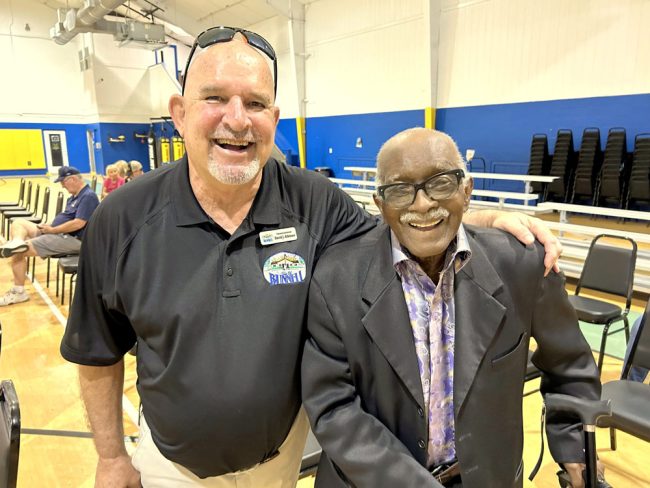
Bunnell History Day also featured two dozen or so presenter tents on the soccer field at the park, including Palm Coast’s African American Cultural Society, the Flagler Beach Historical Museum, Florida State Parks, the American Red Cross and other service organizations, businesses and civic groups.
The event included tours of the Holden House Museum, the home of the Flagler County Historical Society, at 204 East Moody Blvd., and the Little Red School House on the campus of Bunnell Elementary. The Palm Coast Cruisers held a car show, and folk singer-guitarist Chris Kahl presented “A Musical Journey Through Florida” at Bridges United Methodist Church in Bunnell.
At the park, St. Augustine re-enactor Brian Bowman, president of the Historic Florida Militia, detailed Florida’s pre-statehood fortunes in the 1700s, when the Spanish, British and American colonists were fighting for control of its turf.
Katherine Biancaniello, a resident of unincorporated Flagler County whose land is adjacent to Bunnell, handed out flyers headlined “Farms Over Factories” at a booth opposing the proposed rezoning of 1,383 acres of agricultural land in Bunnell to a “heavy industrial” designation. (According to the City of Bunnell website, “During the past few years, the City of Bunnell has annexed over 87,000 acres, making us the second largest city, in land mass, in the State of Florida. This means that we have plenty of undeveloped land ready for investment and future growth.”)
Artist JJ Graham, whose working studio remains in the Flagler Playhouse building given that it was untouched by the fire that ravaged most of the complex in October 2023, unveiled a new painting at a double tent that displayed his art as well as works by Marilyn Leverton, Anastasia Trotter, teen artist Liam Crowley, the late Tom Gargiulo and the late Linda Solomon.

Graham said his still-untitled work, based on an actual old house in the heart of the city, “is part Bunnell and part me.”
Also at the festival, Sonji Jackson watched as her granddaughter Skylar Gunter, soon to be a second grader at Bunnell Elementary, rode a mechanical bull. Her grandson Qruz Jackson sat nervously beside an alligator skin, replete with head, displayed at the Native American-themed tent of Jim Sawgrass, a native Floridian of Muscogee Creek descent and a historian of the southeastern tribes of Florida, Georgia and Alabama.
Bunnell History Days co-organizers Ed Siarkowicz, the president of the Flagler County Historical Society, and Pete Johnson, a 32-year-old handyman and former Palm Coast mayoral candidate, credit Elaine Studnicki, the immediate past president of the Palm Coast Historical Society and a grant writer for the Flagler County Historical Society, with coming up with the idea to celebrate Bunnell’s history.
“Bunnell is a really sweet city,” said Studnicki, who grew up in New Jersey, bought property in Flagler County with her husband, David, in 1982, and retired permanently here with her husband in 2010.
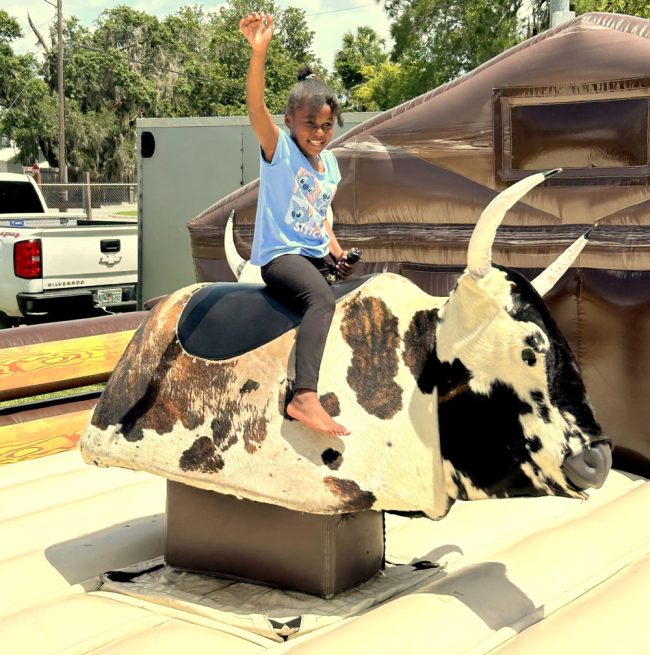
“Once you learn the history, you realize how important Bunnell is to the development of Flagler County at large,” she said. “A lot of the main roads and the main bridges were all done by people who started in Bunnell or moved to Bunnell in the ’20s and ’30s and ’40s.The whole concept of having history be part of this celebration makes it so much more important and sets it apart from other events, because these are things that everybody needs to learn.”
Bunnell is the county seat of Flagler County and has a population of 3,276, according to the 2020 census. It’s nickname, the “Crossroads of Flagler County,” came about in the early 2000s, said Bunnell Mayor Catherine Robinson.
Studnicki wrote a grant proposal that earned Bunnell History Day a $5,000 grant from the Florida Humanities Council. Siarkowicz and Johnson noted that other funds were donated by area businesses and other sponsors, while the City of Bunnell contributed in-kind services.
According to a webpage originating on bunnellcity.us and now found on archive.org, “The Town of Bunnell was officially incorporated in 1913, but its history as a community dates back to the 1880s . . . As with many other communities in Florida, Bunnell owes part of its start to the railroad industry. Alvah Bunnell established a cypress shingle mill and promised to supply the fledgling rail business with wood for its wood burning locomotives. Bunnell Stop was the name identified on the earliest rail route.
“By 1900, Isaac I. Moody and George W. Deen had developed a flourishing turpentine business in the Bunnell area. The name Moody would forever be tied to this area. By 1903, Bunnell was big enough to have a post office. Isaac I. Moody, J.R. Sloan, and James Frank ‘Major’ Lambert formed the Bunnell Development Company in 1909. With that came the formation of Bunnell’s roots. The town of Bunnell was platted, lots and property sold quickly and the new residents began to move in.

“The first permanent house was built by the Bunnell Development Company for Lambert in 1909. The first church (First United Methodist Church) was constructed in 1909 and the Bunnell State Bank opened in 1910. Records from the Bunnell Home Builder, an early periodical for the town, reported that the farms around Bunnell were small but successful in raising sugar cane, corn, sweet potatoes, cucumbers and hay. This created a livelihood that was based on family, farm and community. These are all at the root of this unique, historic, traditional Florida community.”
Studnicki says that “more than any other part of Flagler County, segregation was felt here. It still has remnants of that history – it’s hard to get rid of. And so we reached out to all parts of the community including the Black community to say, ‘Hey, let’s work together and make this city a beautiful place.”
To that end, Bunnell History Day featured not only Pat Mitchell Hines speaking on growing up in Bunnell as a 5th generation African American, but also James Abraham speaking on “Bloody Streets and Crooked Lines: 100 Years of Voter Suppression.”
Both talks were given in the Carver Community Center, which is the only building remaining of George Washington Carver High School, an all-Black school built on Drain Street in 1949 during segregation.

During the opening ceremonies at the center, Carver Center director Bonita Robinson credited the Rev. Frank Giddens, who gave the invocation, with being “the boots on the ground who saved this center” from demolition in 1975.
The opening ceremony was also attended by Mayor Robinson, Vice Mayor John Rogers, City Manager David Atkinson, Flagler County Commissioner Andy Dance and other local officials and dignitaries.
The first two of a proposed series of Bunnell History Trail signs were unveiled, featuring the Delores Deen Doll House and the Southern Bell Telephone Dial House. Both signs will be installed in the coming week, Siarkowicz said: The doll house sign will be installed at 204 E. Moody Blvd., and the dial house sign will go up at 108 N. State St. which is currently the site of eWheelz Golf Carts.
Siarkowicz and Tonya Gordon, vice president of the Flagler County Historical Society, presented a $2,000 check to Palm Coast resident and University of North Florida student Sabrina DaSilva-Carvalheira as the winner of the society’s scholarship competition. Though she’s a nursing major, DaSilva-Carvalheira said she’s “a history fan.”
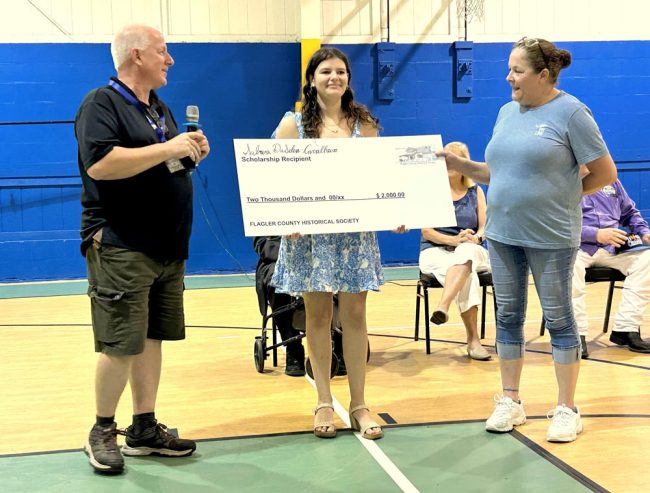
Artist JJ Graham said his untitled painting of a Bunnell house is something of a return to his style as a painter during his younger days in Mississippi, where he would visit juke joints to hear such blues artists as “Junior Kimbrough and R.L. Burnside. When people ask me ‘What kind of painter are you?’ I’m just like ‘Maybe I’m a blues guy who picked up a brush,’ and you can see that it in this painting. There’s a little bit of voodoo in there.”
As Graham alerted viewers that the oil paint of his new work was still drying, he noted that he frequently ventures out of his Flagler Playhouse studio “to look at old houses to paint. I think most of the community thinks I’m homeless when I’m walking around, like ‘Who’s that crazy guy?’ I’m only interested in the old houses. They have a spirit to them and my opinion is it’s because they were built from trees taken from the surrounding area, so there’s this connection. Certain houses here speak to me, and this one kind of whispered to me. It’s over there behind where everybody goes to get chicken.”
Pete Johnson, the co-organizer of Bunnell History Day, said the city “is a beautiful place. It’s lovely – truly wild, old Florida. When people think of Bunnell they usually think of the four-way (the intersection of Moody Boulevard/ S.R. 100 and State Street/U.S. 1), but Bunnell is much more than that as a city.”
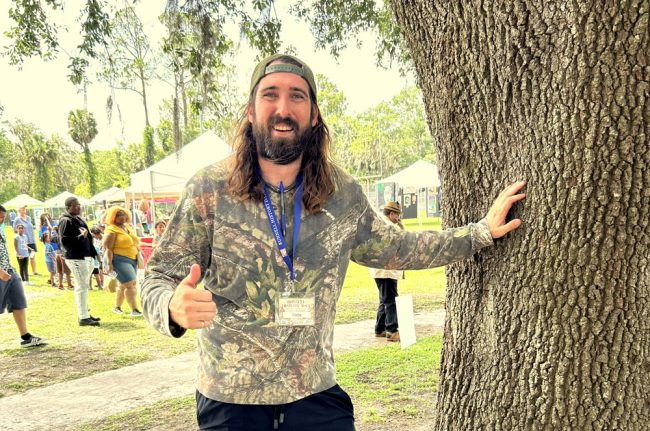
A resident of Palm Coast, Johnson’s family ties to the area go back to that city’s founding, and his family moved to Palm Coast permanently in 2010. In his younger days, he said, most of his friends were Bunnell residents. His love of history was spurred when he ventured into the woods to hunt deer or wild pigs, and he discovered turpentine cups near trees – cups that were used long ago in the area’s once-flourishing turpentine industry.
“So I got involved in history, just in finding a lot of stuff,” Johnson said. “So I do a lot of archeological preservation and artifact recovery for the Flagler County Historical Society. I’m the guy who’s in the woods a lot looking for things.
“Bunnell has a lot of that charm that is quite frankly missing from Palm Coast,” he said. “It’s just an awesome community to be a part of.”
–Rick de Yampert for FlaglerLive
![]()


















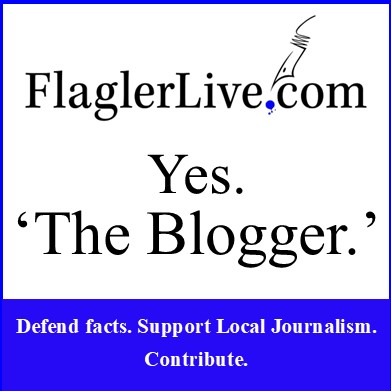







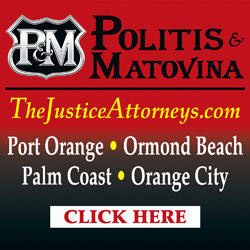




Leave a Reply